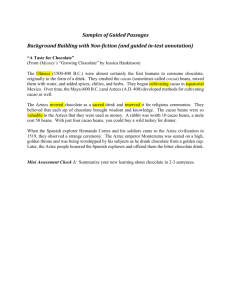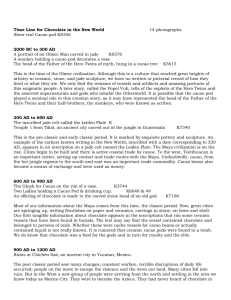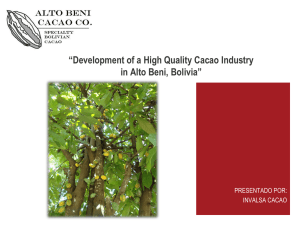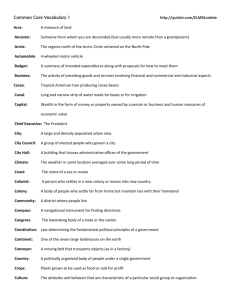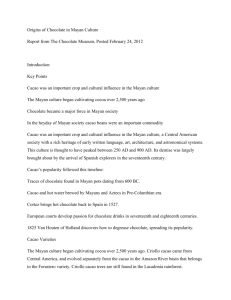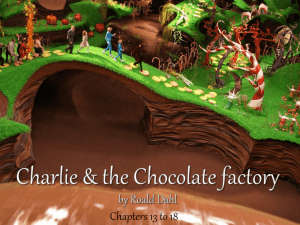how much rainforest is in that chocolate bar?
advertisement
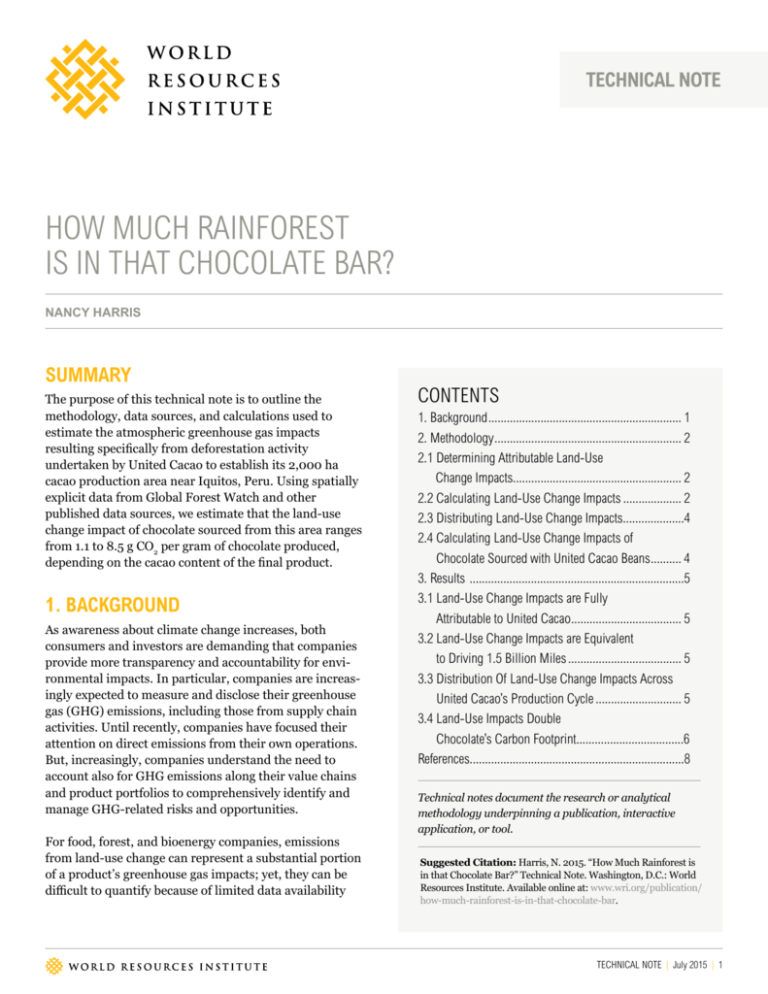
TECHNICAL NOTE HOW MUCH RAINFOREST IS IN THAT CHOCOLATE BAR? NANCY HARRIS SUMMARY The purpose of this technical note is to outline the methodology, data sources, and calculations used to estimate the atmospheric greenhouse gas impacts resulting specifically from deforestation activity undertaken by United Cacao to establish its 2,000 ha cacao production area near Iquitos, Peru. Using spatially explicit data from Global Forest Watch and other published data sources, we estimate that the land-use change impact of chocolate sourced from this area ranges from 1.1 to 8.5 g CO2 per gram of chocolate produced, depending on the cacao content of the final product. 1. BACKGROUND As awareness about climate change increases, both consumers and investors are demanding that companies provide more transparency and accountability for environmental impacts. In particular, companies are increasingly expected to measure and disclose their greenhouse gas (GHG) emissions, including those from supply chain activities. Until recently, companies have focused their attention on direct emissions from their own operations. But, increasingly, companies understand the need to account also for GHG emissions along their value chains and product portfolios to comprehensively identify and manage GHG-related risks and opportunities. For food, forest, and bioenergy companies, emissions from land-use change can represent a substantial portion of a product’s greenhouse gas impacts; yet, they can be difficult to quantify because of limited data availability CONTENTS 1. Background................................................................ 1 2. Methodology.............................................................. 2 2.1 Determining Attributable Land-Use Change Impacts....................................................... 2 2.2 Calculating Land-Use Change Impacts.................... 2 2.3 Distributing Land-Use Change Impacts....................4 2.4 Calculating Land-Use Change Impacts of Chocolate Sourced with United Cacao Beans........... 4 3. Results.......................................................................5 3.1 Land-Use Change Impacts are Fully Attributable to United Cacao..................................... 5 3.2 Land-Use Change Impacts are Equivalent to Driving 1.5 Billion Miles...................................... 5 3.3 Distribution Of Land-Use Change Impacts Across United Cacao’s Production Cycle............................. 5 3.4 Land-Use Impacts Double Chocolate’s Carbon Footprint...................................6 References.......................................................................8 Technical notes document the research or analytical methodology underpinning a publication, interactive application, or tool. Suggested Citation: Harris, N. 2015. “How Much Rainforest is in that Chocolate Bar?” Technical Note. Washington, D.C.: World Resources Institute. Available online at: www.wri.org/publication/ how-much-rainforest-is-in-that-chocolate-bar. TECHNICAL NOTE | July 2015 | 1 and methodological complexities (Plassman et al. 2010). However, remote-sensing technology recently provided evidence (Mongabay 2015) to allow for direct estimation of carbon emissions from a particular case of land-use change. In 2015, United Cacao—a company that aims to produce sustainable cacao (United Cacao 2015)—attracted public attention for clearing 2,000 hectares of rainforest in the Peruvian Amazon for a cacao plantation. Cacao is one of the main ingredients in chocolate. Due to the highly publicized and well-documented nature of this case, our analysis focuses on United Cacao’s clearing activity to estimate the land-use-change portion of the greenhouse gas impacts of chocolate produced using beans grown in the 2,000-hectare area. Due to ever-growing global demand for chocolate (Bloomberg 2013), cacao production has begun to grow in South America (Confectionery News 2014). Peru, the third largest cacao-producing country in South America, has seen a particularly sharp rise in production—a nearly five-fold increase between 1990 and 2013 (FAOSTAT). If United Cacao’s activities are any indication of the effects of Peru’s growing cacao industry and growing global chocolate demand, quantifying the emissions from landuse change for cacao production is an important element in assessing the lifecycle impact of chocolate production. 2. METHODOLOGY The Greenhouse Gas Protocol’s Product Life Cycle Accounting and Reporting Standard (WRI and WBCSD 2011) was used to estimate land-use change emissions that are attributable to United Cacao’s operations near Iquitos, Peru (3.7500° S, 73.2500° W). The analysis did not involve a full lifecycle assessment of United’s activities, but instead focused on those emissions resulting directly from land-use change to establish new areas for cacao production. The GHG Protocol's Product Life Cycle Accounting and Reporting Standard includes methods to calculate landuse change impacts for two situations: when the specific land from which the product or product component originates is known, and when it is not known. When land-use change impacts are attributable, companies shall include these in the assessment boundary and disclose the calculation method in the inventory report. 2 | 2.1 Determining Attributable Land-Use Change Impacts Land-use impacts are attributable to a product if the following are true (WRI and WBCSD 2011): ▪▪ ▪▪ ▪▪ The carbon stock change was the direct result of extraction or production of biogenic material to create a product; The carbon stock change was caused by human intervention with the intent of creating a product; or The carbon stock change occurred within the assessment period—20 years or a single harvest period from the extraction (for example, harvesting) of a biogenic product or product component, whichever timeframe is longer. 2.2 Calculating Land-Use Change Impacts In January 2015, the Global Forest Reporting Network, a partnership between Mongabay and Global Forest Watch, reported that United Cacao cleared roughly 2,000 hectares of primary rainforest for its plantation outside the remote city of Iquitos. Although Iquitos is inaccessible by road, Matt Finer, a research specialist with the Amazon Conservation Association, and his team were able to chronicle the activity using Landsat imagery and provide data for the Global Forest Reporting Network’s story (Figure 1). Once the location of land-use change is known, carbon stock information before and after the change can be used to estimate land-use change impacts. Greg Asner, an ecologist at Stanford University’s Carnegie Institution for Science, analyzed the carbon content of forests across Peru using airborne LiDAR (Asner et al. 2014) and found that there was, on average, more than 122 metric tons (t) of carbon stored per hectare in the tree biomass that was cleared by United Cacao (Figure 2). Estimates of average carbon stocks in cacao plantations vary. We use an estimate of 40t of carbon stored per hectare (Kumar and Nair, 2011) following Somaribba et al.’s (2013) evaluation of systems with similar climate conditions and similar planting densities to those planned by United Cacao. We limit our analysis to carbon stock changes in the aboveground biomass pool only. HOW MUCH RAINFOREST IS IN THAT CHOCOLATE BAR? Figure 1 | Deforestation for United Cacao Plantation near Iquitos, Peru December 2012 0 ha deforest June 2013 150 ha deforest August 2013 1,000 ha deforest September 2013 1,500 ha deforest October 2013 2,000 ha deforest April 2014 2,000 ha deforest Landsat imagery shows the deforestation that occurred on the United Cacao plantation near Iquitos, Peru from December 2012 to April 2014. Source: Matt Finer, Amazon Conservation Association; Sidney Novoa, Asociación para la Conservación de la Cuenca Amazónica; Clinton Jenkins, Instituto de Pesquisas Ecológicas. TECHNICAL NOTE | July 2015 | 3 Figure 2 | Mean Aboveground Carbon Density in United Cacao Plantation Area Mean Aboveground Carbon Density in United Cacao Plantation Area United Cacao Plantation Area United Cacao Plantation Area (showing tree cover loss in 2013) Mean Aboveground Carbon Density Mg C ha-1 141 0 Figure 2. High-resolution (1 ha) forest carbon stock map showing the distribution of forest carbon stocks across Peru. The right side of the figure depicts the boundary of the United Cacao plantation and 2013 tree cover loss data from the University of Maryland and Google as seen on Global Forest Watch. Greenhouse gas impacts per hectare of land-use change were calculated as the difference in average aboveground carbon stocks before and after clearing (122 – 40 = 82 t C ha-1). Overall carbon impacts were calculated by multiplying per-hectare estimates by the total area of clearing (2,000 ha). Carbon was converted to CO2 equivalents (CO2e) using a conversion factor of 3.67. 2.3 Distributing Land-Use Change Impacts Once land-use change impacts are deemed attributable and impacts are identified, these impacts must be distributed because, in most cases, land-use change occurs on land that produces products over many years. Therefore it is not appropriate to apply all the land-use change impacts to the first harvest of products generated within the area. Following the WRI/WBCSD Standard, we distributed 4 | land-use change impacts evenly over an amortization period of 20 years. 2.4 Calculating Land-Use Change Impacts of Chocolate Sourced with United Cacao Beans Cacao beans are just one ingredient in chocolate, so the land-use impacts per quantity of chocolate produced will depend on what percentage of the overall product is made up of cacao beans. One pound of cacao beans yields approximately 0.7 pounds of cocoa nibs (Tejas Chocolate 2013), with the balance lost through sorting, moisture loss during roasting, removing the shell, and losing some cocoa nib during winnowing. Cocoa nibs are then combined with other ingredients (mainly sugar and milk) to produce a final product. The percentage number on a bar’s wrapper HOW MUCH RAINFOREST IS IN THAT CHOCOLATE BAR? represents the weight of the bar that actually comes from the cacao bean. 3.2 Land-Use Change Impacts are Equivalent to Driving 1.5 Billion Miles The percentage of cacao in different brands of chocolate varies widely, with 10 percent as the minimum required by the U.S. Food and Drug Administration (2014) if the product is to be labeled “chocolate.” Hershey’s milk chocolate contains about 11 percent cacao. In contrast, a dark chocolate bar will contain anywhere from 65 percent to 85 percent cacao. We arrived at this estimate by doing a few mathematical conversions (Figure 3): Rather than quantify land-use change impacts according to the quantity of cacao beans produced by United Cacao, our methodology goes a step further to approximate land-use change impacts per quantity of chocolate produced using United Cacao’s beans. We do this to create an impact metric that may resonate more strongly with the average consumer. STEP 3. Multiply by the total number of hectares cleared (301 t CO2 ha-1 x 2,000 ha = 602,000 t CO2). STEP 1. Calculate the difference in average carbon stocks before and after clearing (122 – 40 = 82 t C ha-1). Step 2. Convert carbon to carbon dioxide equivalents (82 t C ha-1 = 301 t CO2 ha-1) STEP 4. Estimate the carbon dioxide emissions from driving a mile in an average American passenger car (411 g CO2 emitted per mile driven) (U.S. EPA 2014). STEP 5. Equate land-use change emissions to an equivalent number of miles driven (602,000 t CO2 = 1.46 billion miles) 3. RESULTS 3.3 Distribution of Land-Use Change Impacts Across United Cacao’s Production Cycle 3.1 Land-Use Change Impacts are Fully Attributable to United Cacao Using United Cacao’s own yield projections (United Cacao) (Figure 4), we estimate that, over the next 20 years, United Cacao will produce approximately 42,850 kg of cacao beans per hectare. Across a planting area of 2,000 hectares, this translates into more than 85,000 t of cacao beans. United Cacao’s estimate of expected yields per In the case of United Cacao, the carbon stock change was caused by human intervention with the intent of creating a product (cacao) and is therefore fully attributable to United Cacao. The specific land from which the product originates is known. Figure 3 | Land-Use Change Emissions in Miles Driven 2,000 Ha of cleared rainforest = 1.5B miles driven by passenger car = 58,819 trips aroun the earth Net carbon emissions from deforestation over the lifetime of United Cacao’s 2,000 hectare plantation translated into miles driven by one passenger car. Using United Cacao’s own yield projections (United Cacao) (Figure 4), we estimate that, over the next 20 years, United Cacao will produce approximately 42,850 kg of cacao beans per hectare. Across a planting area of 2,000 hectares, this translates into more than 85,000t of cacao beans. United Cacao’s estimate of expected yields per hectare is substantially higher than average cocoa yields in Peru, which range between 800 and 2,500 kg per ha (USDA, 2014). TECHNICAL NOTE | July 2015 | 5 Figure 4 | Cacao Yield Projections for United Cacao’s Operations 3000 Projected Cacao Yield (kg/ha) 2500 2000 1500 1000 500 0 1 2 3 4 5 6 7 8 9 10 11 12 13 14 15 16 17 18 19 20 Year Source: United Cacao Corporate Profile (http://www.unitedcacao.com/index.php/en/corporate-profile-eng/cacao-cultivation). hectare is substantially higher than average cocoa yields in Peru, which range between 800 and 2,500 kg per ha (USDA, 2014). 3.4 Land-Use Impacts Double Chocolate’s Carbon Footprint As estimated in Section 3.2, clearing one hectare of forestland resulted in carbon emissions of 301 t CO2, and that same hectare is projected to produce almost 43t of cacao beans over a 20-year production cycle. These beans could then be used to make 35 t to 273 t of chocolate, depending on the quantity of cocoa nibs used in the final product (we used 11 percent and 85 percent for the range given above). 6 | Distributing the greenhouse gas impacts of land-use change (301 t CO2 ha-1) over this production quantity (35 to 273 tons chocolate) results in a land-use change emission impact of 1.1 to 8.52 g CO2 per gram of chocolate produced using United Cacao’s beans. If we assume that Cadbury’s estimate of 3.45 g CO2 per g of chocolate (Food Manufacture 2008) for other components of the production cycle is representative of the industry, then land-use change impacts associated with a 35 percent cacao chocolate bar produced with United Cacao’s beans would result in a doubled carbon footprint of 7 g CO2 per gram of chocolate. A 66 percent cacao chocolate bar produced with United Cacao’s beans would have a tripled carbon footprint of 10 g CO2 per gram of chocolate (Figure 4). HOW MUCH RAINFOREST IS IN THAT CHOCOLATE BAR? Figure 5 | Distribution of Land-Use Change Impacts Across United Cacao’s Production Cycle 200 gram bar of milk chocolate 200 gram bar of milk chocolate produced from cleared rainforest 200 gram bar of dark chocolate produced from cleared rainforest = = = 1.7 mi. CO2 equivalent of 1 passenger car driven 1.7 miles 3.2 mi. CO2 equivalent of 1 passenger car driven 3.2 miles 4.9 mi. CO2 equivalent of 1 passenger car driven 4.9 miles TECHNICAL NOTE | July 2015 | 7 REFERENCES Addy, R. “Cadbury Furthers Carbon Footprint Debate.” Food Manufacture, February 11, 2008. Accessed July 2, 2015. http://www.foodmanufacture. co.uk/Business-News/Cadbury-furthers-carbon-footprint-debate. Plassmann, K., Norton, A., Attarzadeh, N., Jensen, M.P., Brenton, P., and Edwards-Jones, G. “Methodological Complexities of Product Carbon Footprinting: A Sensitivity Analysis of Key Variables in a Developing Country Context.” Environmental Science & Policy: 393-404. Asner, G.P., Knapp, D.E., Martin, R.E., Tupayachi, R., Anderson, C.B., Mascaro, J., Sinca, F., Chadwick, K.D., Higgins, M., Farfan, W., Llactayo, W., and Silman, M.R. “Targeted Carbon Conservation at National Scales with High-resolution Monitoring.” Proceedings of the National Academy of Sciences, 2014. Accessed July 2, 2015. http://www.pnas.org/content/111/47/ E5016.abstract. Somarriba, E., Cerda, R., Orozco, L., Cifuentes, M., Dávila, H., Espin, T., Mavisoy, H., Ávila, G., Alvarado, E., Poveda, V., Astorga, C., Say, E., and Deheuvels, O. 2013. “Carbon Stocks and Cocoa Yields in Agroforestry Systems of Central America.” Agriculture, Ecosystems & Environment: 46–57. “Cacao Cultivation.” United Cacao. Accessed July 2, 2015. http://www. unitedcacao.com/index.php/en/corporate-profile-eng/cacao-cultivation. USDA (United States Department of Agriculture) Foreign Agricultural Service. “Cocoa Update and Outlook Peru.” November 6, 2014. Accessed July 2, 2015. http://gain.fas.usda.gov/Recent GAIN Publications/Cocoa Update and Outlook_Lima_Peru_10-28-2014.pdf. Cannon, J.C. “Company Chops down Rainforest to Produce ‘Sustainable’ Chocolate.” Global Forest Reporting Network, January 20, 2015. Accessed January 20, 2015. http://news.mongabay.com/2015/0120-gfrn-cannoncompany-clears-forest-for-chocolate.html. U.S. EPA (United States Environmental Protection Agency). “Greenhouse Gas Emissions from a Typical Passenger Vehicle.” May 1, 2014. Accessed July 2, 2015. http://www.epa.gov/otaq/climate/documents/420f14040a.pdf. “Code of Federal Regulations Title 21.” U.S. Food and Drug Administration. April 1, 2014. Accessed July 2, 2015. http://www.accessdata.fda.gov/scripts/ cdrh/cfdocs/cfcfr/CFRSearch.cfm?fr=163.130. “World Geodetic System 1984 (WGS 84).” National Geospatial-Intelligence Agency. May 22, 2014. Accessed July 2, 2015. http://earth-info.nga.mil/ GandG/wgs84/. FAOSTAT (Food And Agriculture Organization, Statistics Division). New York, NY. United Nations. Accessed July 2, 2015. http://faostat3.fao.org/ browse/Q/*/E. World Resources Institute and World Business Council for Sustainable Development. “Product Life Cycle Accounting and Reporting Standard.” September 2011. Accessed July 2, 2015. http://www.ghgprotocol.org/files/ ghgp/public/Product-Life-Cycle-Accounting-Reporting-Standard_041613. pdf. Javier, L-A., Almeida, I., and Perez., M.G. “Chocolate Eaters Drive Record Cocoa-Output Deficit: Commodities.” Bloomberg, December 13, 2013. Accessed July 2, 2015. http://www.bloomberg.com/news/articles/2013-12-17/ chocolate-eaters-drive-record-cocoa-output-deficit-commodities. Kumar, B.M., and Ramachandran Nair, P. K., eds. “Carbon Sequestration Potential of Agroforestry Systems Opportunities and Challenges.” Dordrecht: Springer, 2011. “London Stock Exchange Welcomes United Cacao Limited to AIM.” London Stock Exchange Welcomes United Cacao Limited to AIM. Accessed July 6, 2015. http://www.unitedcacao.com/index.php/en/news-media-en/pressreleases/72-london-stock-exchange-welcomes-united-cacao-limited-to-aim. Moore Jr., S. “How Many Cocoa Beans Are in a Chocolate Bar?” Tejas Chocolate. June 5, 2013. Accessed July 2, 2015. http://tejaschocolate.com/ how-many-cocoa-beans-are-in-a-chocolate-bar/. Nieburg, O. “Could West Africa Lose Its Cocoa Crown?” Confectionery News, June 25, 2014. Accessed July 2, 2015. http://www.confectionerynews.com/ Commodities/The-future-of-cocoa-growing-Emerging-markets. 8 | HOW MUCH RAINFOREST IS IN THAT CHOCOLATE BAR? TECHNICAL NOTE | July 2015 | 9 ACKNOWLEDGMENTS ABOUT WRI This publication was made possible by the World Resources Institute’s Forests Program and the Global Forest Watch partnership. The author would like to thank the following people for their insight and assistance: Octavia Payne, Sarah Mann, Ruth Nogueron, Caroline Winchester, Sarah Lake, Francis Gassert, Daryl Ditz, Janet Ranganathan, and Stephen Russell. For their guidance, feedback, and original research, the author would also like to thank: World Resources Institute is a global research organization that turns big ideas into action at the nexus of environment, economic opportunity and human well-being. Greg Asner, Stanford University’s Carnegie Institute for Science Jeff Hayward and Martin Noponen, Rainforest Alliance Matt Finer, Amazon Conservation Association Rhett Butler, Mongabay ABOUT THE AUTHORS Nancy Harris is the Research Manager for the Forests Program at WRI, where she leads the acquisition and generation of new data and analytical content for Global Forest Watch and pursues research through which WRI can advance global understanding of forest dynamics. Contact: nharris@wri.org Our Challenge Natural resources are at the foundation of economic opportunity and human well-being. But today, we are depleting Earth’s resources at rates that are not sustainable, endangering economies and people’s lives. People depend on clean water, fertile land, healthy forests, and a stable climate. Livable cities and clean energy are essential for a sustainable planet. We must address these urgent, global challenges this decade. Our Vision We envision an equitable and prosperous planet driven by the wise management of natural resources. We aspire to create a world where the actions of government, business, and communities combine to eliminate poverty and sustain the natural environment for all people. Our Approach COUNT IT We start with data. We conduct independent research and draw on the latest technology to develop new insights and recommendations. Our rigorous analysis identifies risks, unveils opportunities, and informs smart strategies. We focus our efforts on influential and emerging economies where the future of sustainability will be determined. CHANGE IT We use our research to influence government policies, business strategies, and civil society action. We test projects with communities, companies, and government agencies to build a strong evidence base. Then, we work with partners to deliver change on the ground that alleviates poverty and strengthens society. We hold ourselves accountable to ensure our outcomes will be bold and enduring. SCALE IT We don’t think small. Once tested, we work with partners to adopt and expand our efforts regionally and globally. We engage with decision-makers to carry out our ideas and elevate our impact. We measure success through government and business actions that improve people’s lives and sustain a healthy environment. Copyright 2015 World Resources Institute. This work is licensed under the Creative Commons Attribution 4.0 International License. To view a copy of the license, visit http://creativecommons.org/licenses/by/4.0/ 10 G Street, NE | Washington, DC 20002 | www.WRI.org
